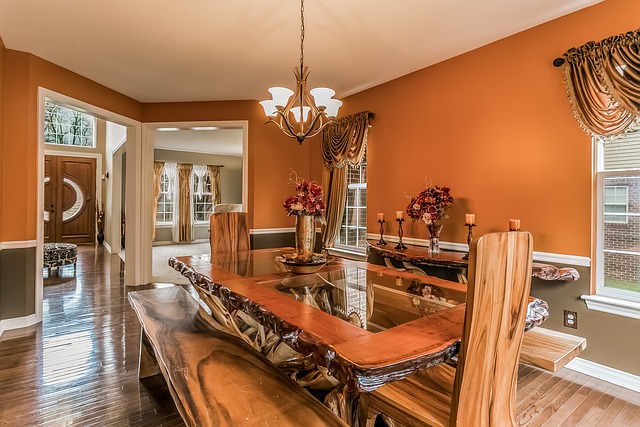Amish dining room sets are known for their timeless appeal, high-quality craftsmanship, and durable construction. The wood selection plays a crucial role in ensuring these pieces remain strong and visually stunning for generations. With traditional woodworking techniques passed down through generations, Amish furniture makers emphasize natural beauty, longevity, and sustainability. Choosing the right wood is essential for achieving a balance between aesthetics and durability, as each wood type has unique grain patterns, hardness levels, and finishes that impact the overall appearance of the furniture. We will explore some of the most popular wood choices for dining room sets at amish kitchen furniture store, examining their characteristics and why they are highly valued in furniture making.
Read more: Concrete Dining Table Materials, Types, and Its Pros and Cons
Oak: Strength and Classic Appeal
Oak is one of the most commonly used woods in Amish dining furniture due to its durability and traditional appearance. This hardwood features a pronounced grain pattern that adds depth and character to dining tables, chairs, and cabinets. It is available in two main types: red oak and white oak. Red oak has a slightly warmer tone, with a reddish-brown hue that complements rustic and classic dining room styles. On the other hand, white oak has a more neutral tone, appearing in shades of beige to light brown, making it ideal for modern or transitional décor. Both types of oak are highly resistant to moisture and everyday wear, making them perfect for dining room sets that see frequent use. Additionally, oak is a heavy wood, ensuring that tables and chairs remain sturdy and resistant to movement or shifting. The ability of oak to take stains and finishes well means that Amish artisans can customize it to match different aesthetics, whether through a natural finish that highlights its grain or a darker stain for a more traditional look.
You May Also Like: How to Prep Your Dining Room for Holiday Hosting
Cherry: Elegance with a Rich Patina
Cherry wood is a favorite for refined, elegant dining room furniture. This hardwood is known for its smooth grain, warm reddish hues, and ability to darken over time, developing a deep, rich patina. The natural aging process of cherry wood adds character, making each dining set unique as it gradually deepens in color. Cherry is slightly softer than oak, making it easier to shape and carve, which is why it is often used in Amish furniture designs that feature intricate details or curved edges. Despite its slightly softer nature, cherry remains highly durable and resistant to warping, ensuring that dining room tables and chairs remain beautiful for decades. It also has a fine, even texture that allows for a smooth finish, making it an excellent choice for those who prefer a polished, elegant look in their dining area.
Maple: A Versatile and Durable Choice
Maple is highly valued in furniture making for its durability, versatility, and uniform grain pattern. This hardwood is commonly used in Amish dining room sets due to its strength and ability to resist scratches and dents. It is ideal for households that experience frequent dining and entertaining. Maple wood comes in two varieties: hard maple and soft maple. Hard maple, or sugar maple, is denser and more durable, while soft maple is slightly less dense but still strong enough for quality furniture. One of the most appealing aspects of maple is its light, creamy color, which allows it to take a wide range of stains and finishes. Whether left in its natural state for a bright and airy dining room aesthetic or stained to resemble cherry or walnut, maple offers flexibility in design. Its smooth grain pattern contributes to a clean and contemporary look, making it a preferred option for traditional and modern Amish furniture styles.
Walnut: A Bold and Luxurious Option
Walnut is a striking choice for Amish dining room sets, known for its deep, rich brown tones and sophisticated appeal. This hardwood is often associated with luxury due to its naturally dark color and distinctive grain patterns. Walnut’s smooth texture and fine grain make it a preferred option for furniture that showcases refined craftsmanship and attention to detail. One of the most significant benefits of walnut is its natural resistance to moisture and warping, ensuring long-lasting durability. Although walnut is slightly softer than oak, it remains strong enough to withstand daily use while maintaining its elegant appearance. Over time, walnut furniture may lighten slightly, but its overall aesthetic remains warm and inviting. Due to its darker hue, walnut is often chosen for dining rooms that aim for a more dramatic or formal ambiance. When paired with lighter upholstery or contrasting wood tones, walnut furniture can create a visually stunning centerpiece in any dining space.
Selecting the right wood for an Amish dining room set ensures longevity and aesthetic appeal. Oak provides strength and a classic look, while cherry offers elegance and a rich patina. Maple delivers durability and versatility, whereas walnut brings sophistication with its deep tones. Hickory adds rustic charm and exceptional durability, while quarter-sawn white oak stands out for its unique grain pattern and stability. Each wood type offers distinct benefits, allowing homeowners to choose a dining set that complements their personal style and practical needs.











Leave a Review